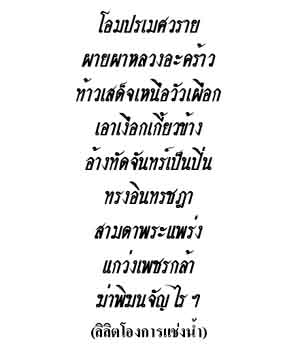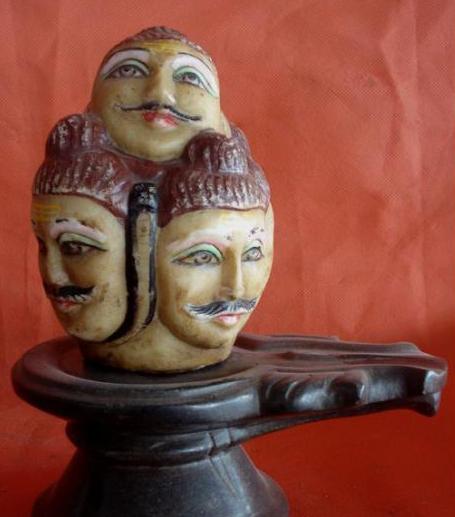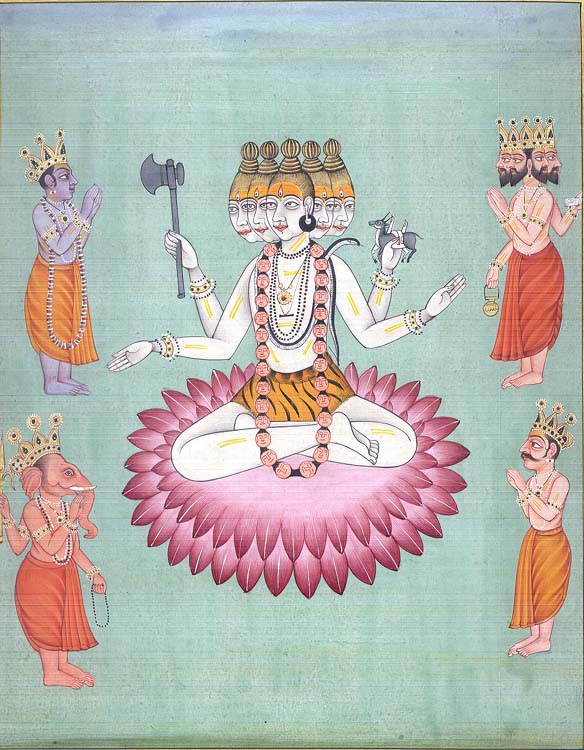Yant Bpanjamukhee – Five faced Shiva Yant
Five Deva faces Yantra – called Yant Bpanjamukhee/pañcamukha in Thai.
The heads of the Devas are topped with “Ongk Pra” (Buddha in Meditation), with sacred Unalomes over them. There is an encoded Kata hidden in three levels of writing between the criss-crosses that connect each of the five faces, which when deciphered read as such;
Idtibpiso Pakawaa Arahang (outer circle) – Na Mo Puttaa ya – Ya Ttaa Pu Mo Na (middle line) – A Sang Wi Su Lo Bu Sa Pu Pa (interior line)
If you notice the third eye in the forehead you may realise that the styling on the faces of the Devas is that of the “Pra” which are often seem in Lai Thai mythological art design, used for Devas, (Taep/??? – as in Taep Panom; the figures often seen in entrances with their hands placed together in reverence, and indeed also as a tattoo), but that the third eye represents the Brahmin God Shiva (pra isworn, in Thai).
The five faced emanation of Shiva is called Bpanjamukhee Arokapay – aroka means “no illnesses” in Pali, and “pay” means dangers. So the five faced emanation of Shiva is to ward off illnesses and related dangers.
Five is a sacred number for Shiva. One of his most important mantras has five syllables. Shiva’s body is said to consist of five mantras, called the pañcabrahmans. As forms of God, each of these have their own names and distinct iconography.
These are represented as the five faces of Shiva and are associated in various texts with the five elements (wind, water, fire, creative function and space), the five senses, the five organs of perception, and the five organs of action. Doctrinal differences and, possibly, errors in transmission, have resulted in some differences between texts in details of how these five forms are linked with various attributes. The overall meaning of these associations is summarized by Stella Kramrisch: “Through these transcendent categories, Shiva, the ultimate reality, becomes the efficient and material cause of all that exists”
According to the Pañcabrahma Upanishad: “One should know all things of the phenomenal world as of a fivefold character, for the reason that the eternal verity of Shiva is of the character of the fivefold Brahman.” (Pañcabrahma Upanishad 31)
(Quote Wikipedia).
In addition, from the Buddhist perspective, this Yant can also be seen to represent the five precepts and the five Dhyani Buddhas. He who keeps the five precepts and makes reverence and offerings to Shiva Bpanjamukhee with his Kata, offerings of incense, milk, flowers and fruits shall be rid of their illnesses and sufferings.
Kata Yant Bpanjamukhee;

For Pure Buddhists this Yant can be seen to mean the five Dhyani Buddhas, and thus one can use their respective katas – or at best use the Kata found inside the Yant itself;
Idtibpiso Pakawaa Arahang – Na Mo Puttaa ya – Ya Ttaa Pu Mo Na – A Sang Wi Su Lo Bu Sa Pu Pa
The Brahmin Way would be as follows;
Om Bparamesawaaraay Phaay Phaa Hlwong Akraaw
Taaw Sadet Hnuea Wua Phueag – Ao Ngueag Gniaw Kang
Aang Tad Jant Bpen Bpin – Song Int Chadaa
Saam Daa Pra Praeng – Gweng Pech Glaa
Kaa Pimon Janrai
Another Kata can also be;
Om Nama Sivaaya (x5, 7, 9, or 108 times)

Pic Left; Five faced Shiva image on a ritual base for pouring milk over. Sculpture made by Yogesh Agrawal.
Shiva is fivefold, his five faces being Ishana, Tatpurusha, Aghora, Vamadeva and Sadjyojata, and eightfold (see puja below) as the eight directions. Shiva-Shakti also have a form called Ardhanarishvara, the meditation image showing the devi as red coloured and voluptuous, as one half of the body, the deva as the other half having a terrifying and fierce aspect.
Mahadeva Shiva is also lord of all beings of the underworld, including bhutas (elementals), pretas (ghosts), and pishachas (flesh eaters) and the rest. He is sometimes pictured on a horse, followed by his retinue of siddhas (accomplished ones), bhairavas (terrifying forms of Shiva), yogis and the rest. As Rudra, he is identified with the star Sirius (Sothis), and is the supreme hunter.
The lingam used in Shiva puja is often made of different materials. While the Todala Tantra recommends lingas made of clay, they are also fashioned from quartz, stone, and in the case of the Matrikabheda Tantra, an alchemical work, from a Mercury amalgam.
Five faced yantra also can mean the life cycle, and in addition, the kata Endings of Buddhist mantras (Ma A U, which mean “Sangha, Buddha and Dhamma” in Buddhist mantras) also have a meaning in Brahminism ;
Life-Cycle Process
Shiva is called Om which represents the five elements of the process of a life-cycle. Om has three sound elements which give the sounds of vowels, such as ‘A’, ‘Ou/U’ and ‘Ma’, and two physical elements, such as a ‘dot’ and a ‘crescent’. ‘A’ represents birth, ‘Ou’ life, ‘Ma’ death, ‘dot’ disintegration of the body into original five elements and ‘crescent’ the soul moving to another physical body or returning to merge with the Supersoul. In the human form, each element of this life-cycle process also represents one face each of the five faces of Shiva. Therefore, Om also stands for Shiva and denotes the Universe.
Shiva is depicted as a five-facad form to represent these five elements that support life on earth. Each face has three eyes, which also represent birth, life and death.
Shiva appears as a luminous lingam. Although it has a special form, the Lingam is considered as a formless and infinite object representing the Lord as the universe. The base of the object representing ‘Ou’ is considered to be ‘Om’ which depicts the Lord and the Universe. Such a set is worshipped as Shiva everywhere in the Hindu world. The lingam also is believed to have five faces. Four faces are usually carved on all four directions and the fifth, which is not carved, is believed to be facing upwards.
Shiva represents the life-cycle and five life- supporting elements which have a form of five faces representing the five elements. The life-cycle represents the creation of life from five elements such as earth, water, fire, air and ether, then the maintenance of life and the completion of life, i.e. death, which means separating the physical body from the soul. The body disintegrates into five elements and returns to their original elementary forms.
Info Link; KOAUSA.ORG

Shiva Puja
Om I bow to Shiva and the five devatas and offer this scent and flower Om! Om I bow to the Sun and the planets and offer this scent and flower Om! Om I bow to the Guardians of the Directions and offer this scent and flower Om! Om I bow to all Goddesses and offer this scent and flower Om! Om I bow to the guru! (Left) Om I bow to the guru’s guru! (Right) Om I bow to the source of the gurus! (Centre) Om I bow to Ganesha. Om namah shivaya. Om hail to Hara. (Establish Linga in North) Om I bow to Maheshvara. (Oblate Linga) Om O One Holding the Trident, truly be here!
Nyasa — Placing
Om Sham I bow to the thumbs Namah. Om Shim I bow the index fingers Svaha. Om Shum I bow to the middle fingers Vashat. Om Shaim I bow to the ring fingers Hum. Om Shaum I bow to the little fingers Vaushat. Om Shah I bow to the front and back of hands Phat. Om Sham to the heart Namah. Om Shim to the head Svaha. Om Shum to the peak Vashat. Om Shaim to the armour Hum. Om Shaum to the 3 eyes Vaushat. Om Shah to the missile Phat.
Dhyana — Meditation
Om. Meditate always on Mahesha, like a mountain of silver, with a beautiful crescent Moon as his crest-gem, whose body is as bright as a jewel, gracious of appearance, his hands holding axe, deer, bestowing boons and dispelling fear, seated in the lotus position, surrounded and praised on all sides by immortals, wearing a tiger-skin, seed and sprout of the Cosmos, destroying fear, with five faces and three eyes. (Place a flower on the head. Perform mental worship. Place the flower on the linga.) O Bearer of the Staff, enter herein! Indwell here! Reside here! Reside here! May happiness be here! May happiness be here! O Rudra, I perform your worship!
Upachara — Offerings
Om hail to Pashupati. (Bathe Linga) Om this is water. Om namah Shivaya! Om this is arghya. Om namah Shivaya! Om this is for sipping. Om namah Shivaya! Om this is for bathing. Om namah Shivaya! Om this is scent. Om namah Shivaya! Om this is flower. Om namah Shivaya! Om this is birch-leaf. Om namah Shivaya! Om this is incense. Om namah Shivaya! Om this is flame. Om namah Shivaya! Om this is food. Om namah Shivaya! Om this is for sipping again. Om namah Shivaya! Om this is betel nut. Om namah Shivaya! Om I offer this scent and flower to Sharva, the Earth form (East) Om I offer this scent and flower to Bhava, the Water form (NE) Om I offer this scent and flower to Rudra, the Fire form (N) Om 1 offer this scent and flower to Ugra, the Air form (NW) Om I offer this scent and flower to Bhima. the Aether form (W) Om I offer this scent and flower to Pashupati, the Magician form (SW) Om I offer this scent and flower to Ishana, the Sun form (S) Om I offer this scent and flower to Mahadeva, the Moon form (SE) Om hail to Nandi. Om hail to Bhringini. Om hail to Kshetrapala. Om hail to Vamadeva.
Japa — Mantra Recitation
Hara Maheshvara Shulapani Pinakadhrik Pashupati Shiva Mahadeva! You are the secret at the core of every secret! Take this recitation! O Maheshvara, of Your grace, bestow siddhi on me! All hail to You, O one with closed eyes! Hail to You, with divine vision! Hail to You who holds the staff! Hail to You who holds the Vajra! Hail to You who holds the trident, sceptre, noose and sword in Your hands! Hail to You, Natha of the Three Worlds, the Lord of all Beings! Om namah Shivaya. Hail to You the Peaceful One! Cause of the 3 Causes! I offer myself to You, O Parameshvara, You who are my goal and refuge!
Nam Nam Nam! I know not how to invoke, nor how to worship, nor how to bid you farewell! Forgive my mistakes, O Parameshvara. (Place flower on head. Close.)
Shiva Info Link;www.shivashakti.com
